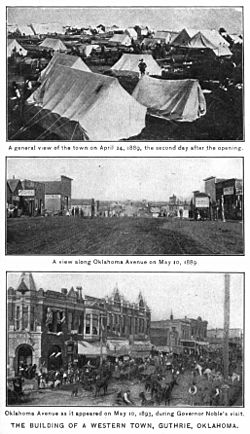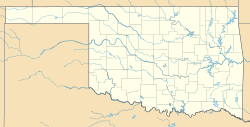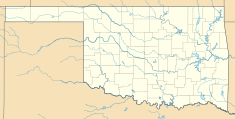Guthrie, Oklahoma facts for kids
Quick facts for kids
Guthrie, Oklahoma
|
|
|---|---|

Downtown Guthrie
|
|
| Country | United States |
| State | Oklahoma |
| County | Logan |
| Government | |
| • Type | Council-Manager |
| Area | |
| • Total | 18.43 sq mi (47.74 km2) |
| • Land | 17.98 sq mi (46.58 km2) |
| • Water | 0.45 sq mi (1.16 km2) |
| Elevation | 1,040 ft (320 m) |
| Population
(2020)
|
|
| • Total | 10,749 |
| • Density | 597.70/sq mi (230.78/km2) |
| Time zone | UTC-6 (CST) |
| • Summer (DST) | UTC-5 (CDT) |
| ZIP code |
73044
|
| Area code(s) | 405/572 |
| FIPS code | 40-31700 |
| GNIS feature ID | 2410678 |
| Website | cityofguthrie.com |
|
Guthrie Historic District
|
|

Tent city on April 24, 1889, the second day after the opening. Two lower images are on May 10, 1889 and 1893 respectively.
|
|
| Location | Guthrie, Oklahoma |
|---|---|
| Built | 1927-29 |
| NRHP reference No. | 74001664 |
| Significant dates | |
| Designated NRHP | June 13, 1974 |
| Designated NHL | January 20, 1999 |
Guthrie is a city in Oklahoma, USA. It's the main city in Logan County and is part of the larger Oklahoma City area. In 2020, about 10,749 people lived there.
Guthrie started as a railroad stop. After the Land Run of 1889, it quickly grew with 10,000 new residents. It became the capital of the Oklahoma Territory and then the first state capital of Oklahoma in 1907. However, in 1910, people voted to move the capital to the bigger city of Oklahoma City.
Guthrie is famous for its many old buildings from the late 1800s and early 1900s. The Guthrie Historic District has over 2,000 historic buildings. It is recognized as a special National Historic Landmark. Many tourists visit Guthrie to see its Victorian architecture, enjoy Wild West shows, take carriage rides, and explore unique shops and art galleries.
Contents
History of Guthrie
Guthrie began in 1887 as a railroad station called Deer Creek. It was on the Southern Kansas Railway line. Later, its name changed to Guthrie, honoring a judge named John Guthrie from Topeka, Kansas. A post office opened there on April 4, 1889.
In 1889, many people gathered to claim land in the Unassigned Lands. On April 22, 1889, at noon, cannons fired to start the "Hoss Race," also known as the Land Run of 1889. People rushed to claim land for farms and towns.
Within six hours, about 10,000 people settled in the area that became Guthrie. It quickly grew into a modern city with brick buildings, running water, electricity, and a public transportation system.
Guthrie has a rich Western history. On April 13, 1898, an outlaw named Richard "Little Dick" West was in town. He was a former member of the Wild Bunch gang. Famous lawmen Heck Thomas and Bill Tilghman found him. West refused to give up and was killed in a gunfight. He is buried in Summit View Cemetery in Guthrie.
Hobart Johnstone Whitley, known as the 'Father of Hollywood,' was the first president of the Guthrie Chamber of Commerce. He built the first brick building in the territory. Whitley convinced the U.S. Congress to make Guthrie the capital of the future state of Oklahoma. This was part of the 1906 Oklahoma Enabling Act. By 1907, when Oklahoma became a state, Guthrie looked like a well-established city.
Guthrie thrived as the territory's main center. However, Oklahoma City grew much faster in the early 1900s. Oklahoma City became a major railroad hub and had a large meat packing industry. Business leaders in Oklahoma City soon wanted their city to be the state capital.
In 1910, a special election was held to decide the capital's location. Oklahoma City received many more votes than Guthrie. The Governor, Charles N. Haskell, ordered the state seal to be moved to Oklahoma City.
After the capital moved, Guthrie lost many government jobs and residents. Its population decreased, and it was no longer Oklahoma's second-largest city. The move was challenged in court, but both the Oklahoma Supreme Court and the United States Supreme Court upheld the decision.
In 1999, the central part of Guthrie was named a National Historic Landmark. This recognized the city's important role in state history and its beautiful architecture.
Guthrie's Culture and Attractions
Because Guthrie lost its status as the capital early on, it has a very well-preserved Victorian area. While other cities like Oklahoma City tore down old buildings for new growth, much of Guthrie's original downtown is still standing.
The National Finals Steer Roping Rodeo is held in Guthrie. This event brings many rodeo fans to the city.
Tourism is a big part of Guthrie's economy. Guthrie has the largest urban Historic district in Oklahoma. It includes 2,169 buildings across 400 city blocks.
Guthrie has two lakes, Liberty Lake and Guthrie Lake. It also has the Oklahoma Territorial Museum. The city hosts the Oklahoma International Bluegrass Festival, which attracts 15,000 visitors every year. Guthrie is also known as the "Bed and Breakfast capital of Oklahoma."
Guthrie is home to the Guthrie Scottish Rite Masonic Temple. This is one of the largest Masonic Centers in the world. Famous artists like Henry Mancini and Luciano Pavarotti have performed there.
Guthrie has Oklahoma's oldest year-round professional theater company, the Pollard Theatre Company. They perform many plays and musicals each year. Their annual holiday show is A Territorial Christmas Carol.
The local newspaper is the Guthrie News-Leader.
Geography and Climate
Guthrie is located in the middle of Oklahoma, in the Frontier Country region. It is about 32 miles (51 km) north of Oklahoma City. The city is along a main route to Texas and Mexico.
The city covers about 19.2 square miles (49.7 square kilometers). Most of this area is land, with a small part being water.
Guthrie is in the Sandstone Hills region of Oklahoma. This area has hills that are 250 to 400 feet (76 to 122 meters) high. It also has oak forests and an ecological area called the Cross Timbers.
Weather in Guthrie
Guthrie has a humid subtropical climate. This means the weather can change a lot from day to day and season to season. Summers are usually hot and humid. Winds, often from the south, help to cool things down in the summer. In winter, winds from the north can make cold periods feel even colder.
| Climate data for Guthrie, Oklahoma | |||||||||||||
|---|---|---|---|---|---|---|---|---|---|---|---|---|---|
| Month | Jan | Feb | Mar | Apr | May | Jun | Jul | Aug | Sep | Oct | Nov | Dec | Year |
| Mean daily maximum °F (°C) | 48.0 (8.9) |
53.8 (12.1) |
64.1 (17.8) |
74.4 (23.6) |
81.6 (27.6) |
89.3 (31.8) |
95.5 (35.3) |
94.9 (34.9) |
86.1 (30.1) |
75.7 (24.3) |
61.7 (16.5) |
51.1 (10.6) |
73.0 (22.8) |
| Mean daily minimum °F (°C) | 24.6 (−4.1) |
29.5 (−1.4) |
38.5 (3.6) |
49.2 (9.6) |
57.7 (14.3) |
66.4 (19.1) |
71.0 (21.7) |
69.5 (20.8) |
62.2 (16.8) |
50.5 (10.3) |
38.9 (3.8) |
28.6 (−1.9) |
48.9 (9.4) |
| Average precipitation inches (mm) | 1.2 (30) |
1.7 (43) |
2.8 (71) |
2.7 (69) |
5.0 (130) |
4.2 (110) |
2.3 (58) |
2.3 (58) |
4.3 (110) |
2.7 (69) |
2.3 (58) |
1.5 (38) |
32.9 (840) |
| Source 1: weather.com | |||||||||||||
| Source 2: Weatherbase | |||||||||||||
People in Guthrie
| Historical population | |||
|---|---|---|---|
| Census | Pop. | %± | |
| 1890 | 5,333 | — | |
| 1900 | 10,006 | 87.6% | |
| 1910 | 11,654 | 16.5% | |
| 1920 | 11,757 | 0.9% | |
| 1930 | 9,582 | −18.5% | |
| 1940 | 10,018 | 4.6% | |
| 1950 | 10,113 | 0.9% | |
| 1960 | 9,502 | −6.0% | |
| 1970 | 9,575 | 0.8% | |
| 1980 | 10,312 | 7.7% | |
| 1990 | 10,518 | 2.0% | |
| 2000 | 9,925 | −5.6% | |
| 2010 | 10,191 | 2.7% | |
| 2020 | 10,749 | 5.5% | |
| U.S. Decennial Census | |||
In 2000, there were 9,925 people living in Guthrie. There were 3,854 households. About 29.2% of households had children under 18. About 46.7% were married couples.
The population was spread out by age. About 24.7% were under 18. About 17.7% were 65 or older. The average age was 37 years old.
Notable People from Guthrie
Many interesting people have connections to Guthrie:
- Byron Berline – A famous bluegrass musician.
- Leon Breeden – A musician and educator.
- John Hazelton Cotteral – A United States judge.
- Bill Doolin – An outlaw who founded the Wild Bunch; he is buried in Guthrie.
- Dennis Thomas Flynn – A postmaster and delegate.
- Helen Holmes – A journalist, historian, and former mayor of Guthrie.
- Jerry Hopper – A film and television director.
- Joshua Key – A U.S. Army soldier.
- France Laux – A baseball broadcaster.
- Carrie Nation – A well-known advocate for Prohibition.
- Ted Power – A former professional baseball player.
- Peter Ramondetta – A professional skateboarder.
- Horace Speed – The first District Attorney for Oklahoma Territory.
- Gene Stephenson – A college baseball coach.
- Phil Stephenson – A former MLB player.
- W.K. Stratton – An author and journalist.
- Stanley Vestal – An author of the American Old West.
- Hobart Johnstone Whitley – A land developer and banker.
See also
 In Spanish: Guthrie (Oklahoma) para niños
In Spanish: Guthrie (Oklahoma) para niños





